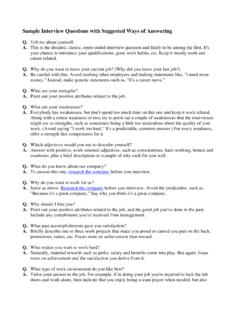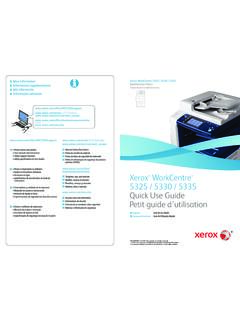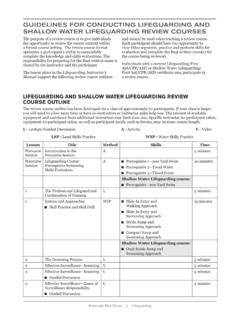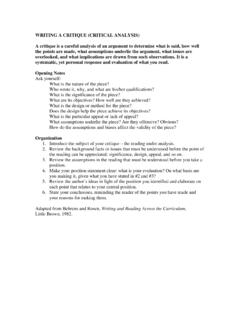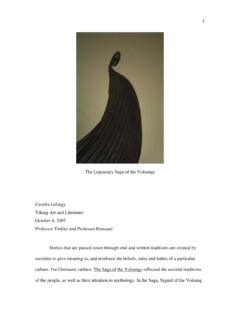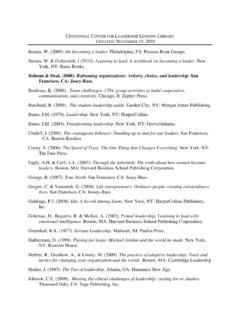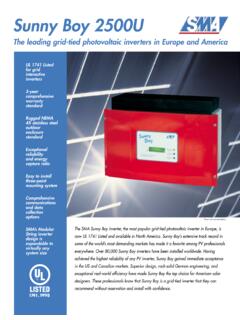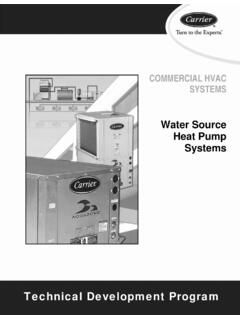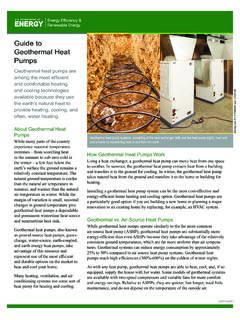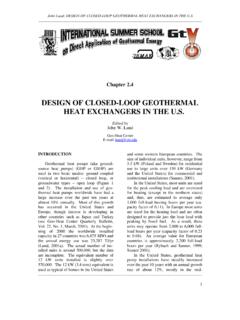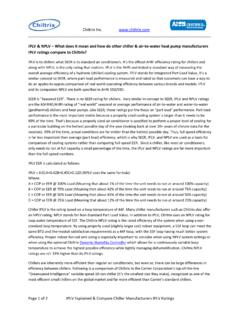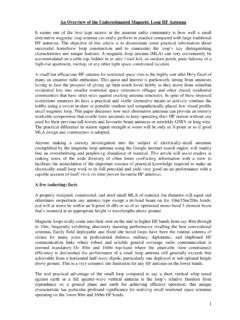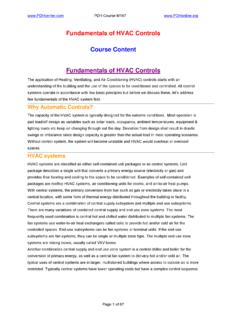Transcription of GEOTHERMAL HEATING AND COOLING
1 GEOTHERMAL HEATING AND COOLING INTRODUCTION GEOTHERMAL HEATING and COOLING Systems provide space conditioning -- HEATING , COOLING , and humidity control. They may also provide water HEATING -- either to supplement or replace conventional water heaters. GEOTHERMAL HEATING and COOLING Systems work by moving heat , rather than by converting chemical energy to heat like in a furnace. Every GEOTHERMAL HEATING and COOLING Systems has three major subsystems or parts: a GEOTHERMAL heat pump to move heat between the building and the fluid in the earth connection, an earth connection for transferring heat between its fluid and the earth, and a distribution subsystem for delivering HEATING or COOLING to the building. Each system may also have a desuperheater to supplement the building's water heater, or a full-demand water heater to meet all of the building's hot water needs. GEOTHERMAL heat Pump The GEOTHERMAL heat pump is packaged in a single cabinet, and includes the compressor, loop-to-refrigerant heat exchanger, and controls.
2 Systems that distribute heat using ducted air also contain the air handler, duct fan, filter, refrigerant-to-air heat exchanger, and condensate removal system for air conditioning. For home installations, the GEOTHERMAL heat pump cabinet is usually located in a basement, attic, or closet. In commercial installations, it may be hung above a suspended ceiling or installed as a self-contained console. Distribution Subsystem Most residential GEOTHERMAL systems use conventional ductwork to distribute hot or cold air and to provide humidity control. (A few systems use water-to-water heat pumps with one or more fan-coil units, baseboard radiators, or under-floor circulating pipes.) Properly sized, constructed, and sealed ducts are essential to maintain system efficiency. Ducts must be well insulated and, whenever possible, located inside of the building's thermal envelope (conditioned space).
3 GEOTHERMAL HEATING and COOLING systems for large commercial buildings, such as schools and offices, often use a different arrangement. Multiple heat pumps (perhaps one for each classroom or office) are attached to the same earth connection by a loop inside the building. This way, each area of the building can be individually controlled. The heat pumps on the sunny side of the building may provide COOLING while those on the shady side are providing heat . This arrangement is very economical, as heat is merely being transferred from one area of the building to another, with the earth connection serving as the heat source or heat sink only for the difference between the building's HEATING and COOLING needs. Water HEATING Many residential-sized systems installed today are equipped with desuperheaters to provide domestic hot water when the system is providing heat or air conditioning.
4 The desuperheater is a small auxiliary heat exchanger at the compressor outlet. It transfers excess heat from the compressed gas to a water line that circulates water to the house's hot water tank. In summer, when the air conditioning runs frequently, a desuperheater may provide all the hot water needed by a household. It can provide four to eight gallons of hot water per ton of COOLING capacity each hour it operates. A desuperheater provides less hot water during the winter, and none during the spring and fall when the system is not operating. Because the heat pump is so much more efficient than other means of water HEATING , manufacturers are beginning to offer "triple function," "full condensing," or "full demand" systems that use a separate heat exchanger to meet all of a household hot water needs. These units cost-effectively provide hot water as quickly as any competing system.
5 The water HEATING system that is installed in the Finger Lakes Institute is an on demand system. This system provides hot water as soon as there is a demand for it. Using this type of system eliminates the need to heat stored water like a conventional hot water tank requires. Types of Systems GEOTHERMAL systems use the earth as a heat source and heat sink. A series of pipes, commonly called a "loop," carry a fluid used to connect the GEOTHERMAL system's heat pump to the earth. Closed and Open loops There are two basic types of loops : closed and open. Open loop systems are the simplest. Used successfully for decades, ground water is drawn from an aquifer through one well, passes through the heat pump's heat exchanger, and is discharged to the same aquifer through a second well at a distance from the first. Generally, two to three gallons per minute per ton of capacity are necessary for effective heat exchange.
6 Since the temperature of ground water is nearly constant throughout the year, open loops are a popular option in areas where they are permitted. Open loop systems do have some associated challenges: Some local ground water chemical conditions can lead to fouling the heat pump's heat exchanger. Such situations may require precautions to keep carbon dioxide and other gases in solution in the water. Other options include the use of cupronickel heat exchangers and heat exchangers that can be cleaned without introducing chemicals into the groundwater. Increasing environmental concerns mean that local officials must be consulted to assure compliance with regulations concerning water use and acceptable water discharge methods. For example, discharge to a sanitary sewer system is rarely acceptable. A closed loop system is being used for the Finger Lakes Institute. Closed loop systems are becoming the most common.
7 When properly installed, they are economical, efficient, and reliable. Water (or a water and antifreeze solution) is circulated through a continuous buried pipe keeping. The closed loop system is environmentally friendly because water in the loop prevents contamination to the external environment. The length of loop piping varies depending on ground temperature, thermal conductivity of the ground, soil moisture, and system design. (Some heat pumps work well with larger inlet temperature variations, which allows marginally smaller loops ). Horizontal loops Horizontal closed loop installations are generally most cost-effective for small installations, particularly for new construction where sufficient land area is available. These installations involve burying pipe in trenches dug with back-hoes or chain trenchers. Up to six pipes, usually in parallel connections, are buried in each trench, with minimum separations of a foot between pipes and ten to fifteen feet between trenches.
8 Vertical loops Vertical closed loops are preferred in many situations. For example, most large commercial buildings and schools use vertical loops because the land area required for horizontal loops would be prohibitive. Vertical loops are also used where the soil is too shallow for trenching. Vertical loops also minimize the disturbance to existing landscaping. For vertical closed loop systems, a U-tube (more rarely, two U-tubes) is installed in a well drilled 100 to 400 feet deep. Because conditions in the ground may vary greatly, loop lengths can range from 130 to 300 feet per ton of heat exchange. Multiple drill holes are required for most installations, where the pipes are generally joined in parallel or series-parallel configurations. A vertical loop well field, being used for the Finger Lakes Institute, consists of 20 wells, drilled to a depth of 100 . There are 5 (clusters) of 4 wells spaced approximately 12 feet on center, The depth and number of wells was nd COOLING load required maintain a comfortable environment for the occ determined by the estimated heat aupants.
9 Linky loops singly, "Slinky" coils -- overlapping coils of polyethylene pipe -- are used to increase the heat xchangond loops closed loops are a special kind of closed loop system. Where ere is owion GEOTHERMAL HEATING and COOLING systems can be connected to the ety of ways -- all thoroughly field proven. However, high S Increaee per foot of trench, but require more pipe per ton of capacity. Two-pipe systems may require 200 to 300 feet of trench per ton of nominal heat exchange capacity. The trench length decreases as the number of pipes in the trench increases -- or as Slinky coil overlap increases. (Illustration below shows a slinky coil in a pond) P Pond tha pond or stream that is deep enough and with enough flow, closed loop coils can be placed on the pond bottom. Fluid is pumped just as for a conventional closed loop ground system where conditions are suitable, the economics are very attractive, and no aquatic system impacts have been sh Conclusn.
10 Earth in a variperformance requires the use of experienced professionals who understand local conditions. Ground Loop today to discuss the best system for you. DETAILS AND DIAGRAMS INTRODUCTION Refrigerators and air conditioners both contain heat pumps. In a refrigerator, heat is moved from the food storage sections and discharged to the kitchen air. Air conditioners work the same way -- they move heat from the inside of a building and discharge it to the outside air. Conventional or air source heat pumps differ from those in a refrigerator or air conditioner because they are reversible -- they can concentrate heat from the outside air and move it inside to provide warmth, as well as move heat out of the building to provide COOLING . To do this, air-source heat pumps (and central air conditioners) need a large outside unit to exchange heat with the outdoor air. GEOTHERMAL HEATING and COOLING Systems In a GEOTHERMAL HEATING and COOLING system, the heat pump is connected to the building by a distribution system -- most commonly air ducts.
